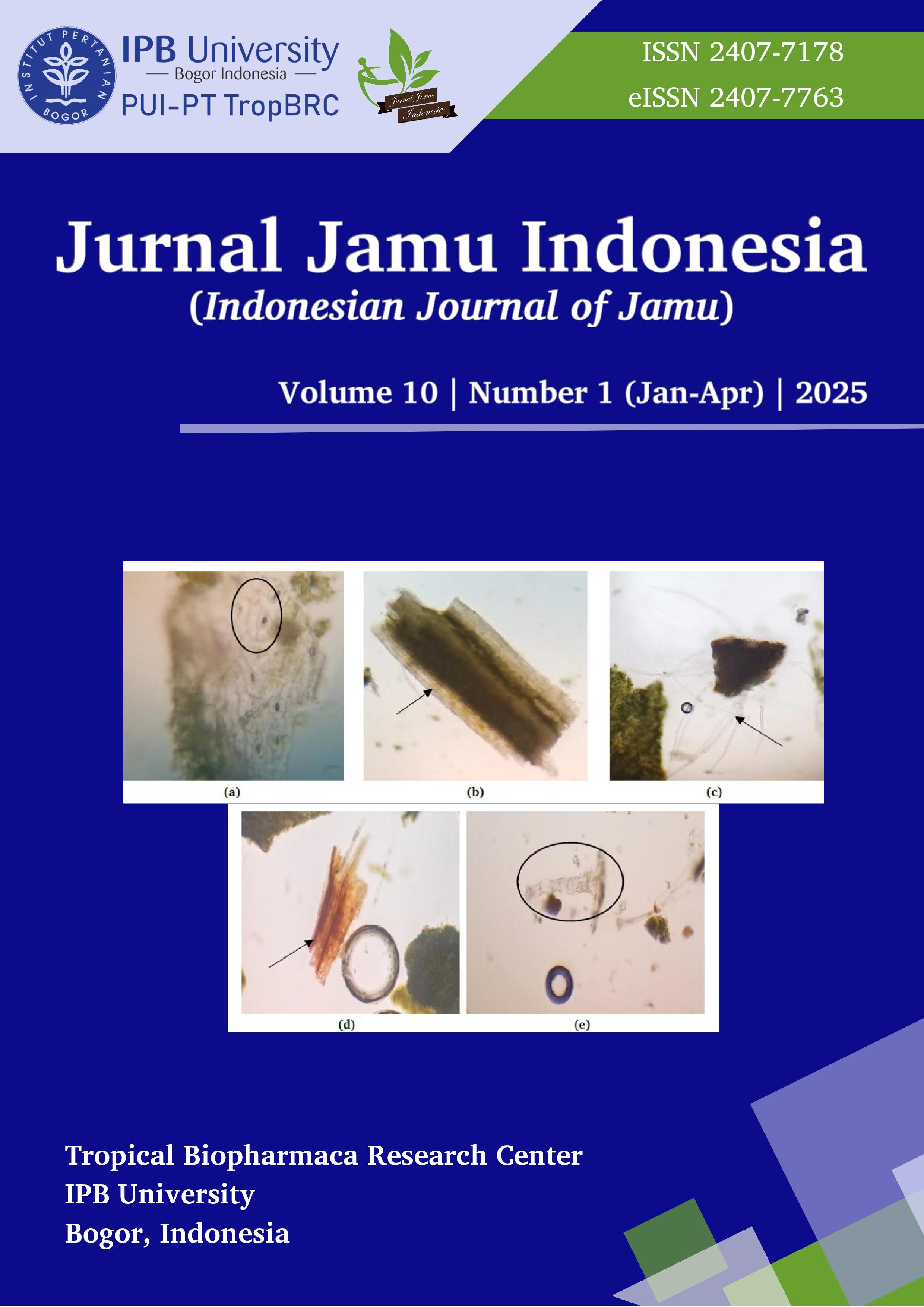Standardization of 96% Ethanol Extract of Beluntas Leaves, Kenikir Leaves, and Purple Corn Kernels
Abstract
Beluntas (Pluchea indica) leaves, kenikir (Cosmos caudatus) leaves, and purple corn (Zea mays) kernels have the potential to be developed into preparations of traditional medicine, which requires standardization of raw materials. The 96% ethanol extract P. indica leaves from Batu, C. caudatus leaves from Wonosari, and purple corn kernels from Sukabumi have been standardized. Both specific and non-specific requirements are covered. Fragment identifiers of P. indica leaves, such as stomata and trichoma. C. caudatus leaves, such as vascular tissue with stair thickening and multicellular hair covering. Purple corn kernels such as amylum and hilum in the form of stars. The thick extracts were obtained from the results of ultrasonic-assisted extraction with yields of 14.76% for P. indica leaves, 7.49% for C. caudatus leaves, and 5.79% for purple corn kernels. The organoleptic of ethanolic extract P. indica leaves is thick and greenish-black, C. caudatus leaves is thick and brown, and purple corn kernels is thick and purple. The water-soluble content from P. indica leaves, C. caudatus leaves, and purple corn kernels was 13.85%, 11.13%, and 10.62%, respectively. The ethanol soluble content was 16.58%, 14.87%, and 15.89%. The total ash content for P. indica leaves, C. caudatus leaves, and purple corn kernels was 15.04%, 9.37%, and 4.76%. The percentage of water content was 9.07%, 14.34%, and 11.12%. The standardized data collected was compared with the requirements in the official monographs of Materia Medika Indonesia and Farmakope Herbal Indonesia. The results showed that the three samples used had met most of the standardization parameters and could be developed into traditional medicine.
Full text article
References
Anggorowati, D., Priandini, G., & Thufail. (2016). Potensi daun alpukat (persea americana miller) sebagai minuman teh herbal yang kaya antioksidan. Industri Inovatif, 6(1), 1–7.
Buanasari, Febrianto, Y., Cholifah, & Chakim, A. (2019). Potensi Metode Ultrasonic-Assisted Extraction (UAE) Dalam Mengekstrak Senyawa Aktif Dari Bahan Alam. Jurnal Farmasi Dan Sains Indonesia, 2(1), 106–111.
Chemat, F., Zill-E-Huma, & Khan, M. K. (2011). Applications of ultrasound in food technology: Processing, preservation and extraction. Ultrasonics Sonochemistry, 18(4), 813–835. https://doi.org/10.1016/J.ULTSONCH.2010.11.023
Depkes, RI. (2000). Parameter Standar Umum Ekstrak Tumbuhan Obat.
Dewi, S. R., Argo, B. D., & Ulya, N. (2018). Kandungan Flavonoid dan Aktivitas Antioksidan Ekstrak Pleurotus ostreatus. Rona Teknik Pertanian, 11(1), 1–10. https://doi.org/10.17969/rtp.v11i1.9571
Dyah Nur Azizah, Endang Kumolowati, F. F. (2014). Penetapan Kadar Flavonoid Metode Alcl3 pada Ekstrak Metanol Kulit Buah Kakao (Theobroma cacao L.). Kartika : Jurnal Ilmiah Farmasi, 2014(2), 45–49.
Elvira, E., Abidin, Z., & Razak, R. (2024). Analisis Kandungan Flavonoid Ekstrak Etanol Daun Kenikir (Cosmos caudatus). Makassar Pharmaceutical Science Journal, 1(37), 347–357. https://journal.farmasi.umi.ac.id/index.php/mpsj
Fitriansyah, M. I., & Indradi, R. B. (2017). Review: Profil Fitokimia dan Aktivitas Farmakologi Baluntas (Pluchea indica L.). Farmaka, 16(2), 337–346.
Handaratri, A., & Yuniati, Y. (2019). Kajian Ekstraksi Antosianin dari Buah Murbei dengan Metode Sonikasi dan Microwave. Reka Buana : Jurnal Ilmiah Teknik Sipil Dan Teknik Kimia, 4(1), 63. https://doi.org/10.33366/rekabuana.v4i1.1162
Republik Indonesia, K. K. (2017). Farmakope Herbal Indonesia. https://doi.org/10.2307/jj.2430657.12
Isnawati, A., Alegantina, S., Raini, M., & Nikmah, B. (2004). Karakterisasi Simplisia dan Ekstrak Daun Strobilanthus crispus. In Media Litbang Kesehatan (Vol. 14, Issue 2, pp. 1–6).
Kementerian Kesehatan Republik Indonesia. (2017). Farmakope Herbal Indonesia.
Masitah, M., Pribadi, T., Pratama, M. I., Harrist, R. F., Sari, P. A., Dianita, F., & Setiawan, V. K. (2023). Analisis Kandungan Metabolik Sekunder pada Daun Kenikir (Cosmos Caudatus Kunth.) dengan Pelarut Metanol, Etanol, dan Etil Asetat. BIOEDUKASI (Jurnal Pendidikan Biologi), 14(2), 266. https://doi.org/10.24127/bioedukasi.v14i2.7805
Nurhaeni, F., Trilestari, Wahyuono, S., & Rohman, A. (2014). Aktivitas Antioksidan Ekstrak Etanolik Berbagai Jenis Sayuran Serta Penentuan Kansungan Fenolik Dan Flavonoid Totalnya. Media Farmasi, 11(2), 167–178.
Putri, & Prahasti, A. E. (2022). Pengaruh Metode Maserasi dan Ultrasonik terhadap Ukuran Partikel Ekstrak Kulit Buah Kakao (Theobroma cacao). Jurnal Kedokteran Gigi Terpadu, 4(1), 1–6.
Salamah, M.Sc, Apt., N., Rozak, M., & Al Abror, M. (2017). Pengaruh metode penyarian terhadap kadar alkaloid total daun jembirit (Tabernaemontana sphaerocarpa. BL) dengan metode spektrofotometri visibel. Pharmaciana, 7(1), 113. https://doi.org/10.12928/pharmaciana.v7i1.6330
Setyani, I. K., Wahyono, W., & Sulaiman, T. N. S. (2021). Standardisasi Simplisia dan Ekstrak Buah Kemukus (Piper cubeba Lf.) Sebagai Bahan Baku Sediaan Kapsul Jamu Sesak Nafas. JPSCR: Journal of Pharmaceutical Science and Clinical Research, 6(3), 238. https://doi.org/10.20961/jpscr.v6i3.50372
Silalahi, M. (2021). Gnetum gnemon L. Gnetaceae. January, 531–537. https://doi.org/10.1007/978-3-030-38389-3_121
Surbhi Kesharwani, Pushpa Prasad, Amit Roy, & Ram Kumar Sahu. (2014). An Overview on Phytochemistry and Pharmacological Explorations of Moringa oleifera. Pharmaceutical and Biosciences Journal, 2(1), 34–41. https://doi.org/10.20510/ukjpb/2/i1/91151
Utami, R. R., Supriyanto, S., Rahardjo, S., & Armunanto, R. (2017). Aktivitas Antioksidan Kulit Biji Kakao dari Hasil Penyangraian Biji Kakao Kering pada Derajat Ringan, Sedang dan Berat. Agritech, 37(1), 89. https://doi.org/10.22146/agritech.10454
Werdhawati, A. (2014). Peran Antioksidan Untuk Kesehatan. Biotek Medisiana Indonesia, 3(1), 59–68.
Authors

This work is licensed under a Creative Commons Attribution-NonCommercial-ShareAlike 4.0 International License. Copyright @2017. This is an open-access article distributed under the terms of the Creative Commons Attribution-NonCommercial-ShareAlike 4.0 International License (http://creativecommons.org/licenses/by-nc-sa/4.0/) which permits unrestricted non-commercial used, distribution and reproduction in any medium

